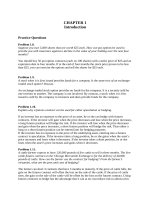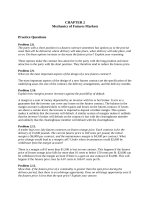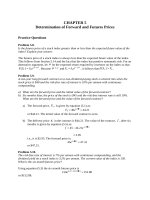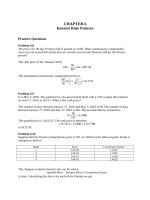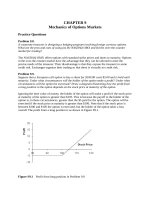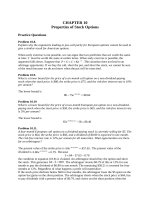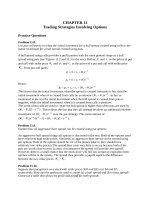Test bank fundamentals of futures and options markets 7e by hull chapter 15
Bạn đang xem bản rút gọn của tài liệu. Xem và tải ngay bản đầy đủ của tài liệu tại đây (33.76 KB, 2 trang )
Test Bank: Chapter 15
Options on Stock Indices and Currencies
1. A portfolio manager in charge of a portfolio worth $10 million is concerned that the
market might decline rapidly during the next six months and would like to use options
on the S&P 100 to provide protection against the portfolio falling below$9.5 million.
The S&P 100 index is currently standing at 500 and each contract is on 100 times the
index.
(i) If the portfolio has a beta of 1, how many put option contracts should be
purchased? _ _ _ _ _ _
(ii) If the portfolio has a beta of 1, what should the strike price of the put options
be? _ _ _ _ _ _
(iii)If the portfolio has a beta of 0.5, how many put options should be purchased?
______
(iv) If the portfolio has a beta of 0.5, what should the strike prices of the put
options be? Assume that the risk-free rate is 10% and the dividend yield on
both the portfolio and the index is 2%. _ _ _ _ _ _
2. To create a range forward contract in order to hedge foreign currency that will be
received a company should (Circle one)
(a) Buy a put and sell a call on the currency with the strike price of the put higher
than that of the call
(b) Buy a put and sell a call on the currency with the strike price of the put lower than
that of the call
(c) Buy a call and sell a put on the currency with the strike price of the put higher
than that of the call
(d) Buy a call and sell a put on the currency with the strike price of the put lower than
that of the call
3. To create a range forward contract in order to hedge foreign currency that will be paid
a company should (Circle one)
(a) Buy a put and sell a call on the currency with the strike price of the put higher
than that of the call
(b) Buy a put and sell a call on the currency with the strike price of the put lower than
that of the call
(c) Buy a call and sell a put on the currency with the strike price of the put higher
than that of the call
(d) Buy a call and sell a put on the currency with the strike price of the put lower than
that of the call
4. Consider a European put option on a index. The index level is 1,000, the strike price is
1050, the time to maturity is six months, the risk-free rate is 4% per annum, and the
dividend yield on the index is 2% per annum. What is a lower bound to the option
price? (Give two decimal places.) _ _ _ _ _ _
5. Consider a European call option on a currency. The exchange rate is 1.0000, the strike
price is 0.9100, the time to maturity is one year, the domestic risk-free rate is 5% per
annum, and the foreign risk-free rate is 3% per annum. What is a lower bound to the
option price? (Give four decimal places.) _ _ _ _ _ _
6. Options on an exchange rate can be valued using the formula for an option of a stock
paying a continuous dividend yield where the dividend yield is replaced by (Circle
one)
(a) the domestic risk-free rate
(b) the foreign risk-free rate
(c) the foreign risk-free rate minus the domestic risk-free rate
(d) none of the above
7. The put call parity formula for options on a currency is the same as that for options on
a non-dividend-paying stock except that
qT
(a) S0 is replaced by S0e
rT
(b) S0 is replaced by S0e
−qT
(c) S0 is replaced by S0e
−rT
(d) S0 is replaced by S0e
